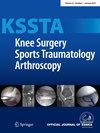High incidence of post-operative re-sprain following suture tape implantation for anterior talofibular ligament insufficiency and risk factors for post-operative re-sprain
Abstract
Purpose
Anterior talofibular ligament (ATFL) insufficiency encompasses situations in which (i) frequent sprains cause ATFL loss, as evidenced by ATFL non-visualization on preoperative magnetic resonance imaging; or (ii) minimal healthy ATFL tissue for repair is left after the removal of the large os subfibulare. Suture tape implantation can be indicated for these cases rather than conventional ligament repair. This study was designed to investigate the incidence of post-operative re-sprain in patients who underwent suture tape implantation for ATFL insufficiency, and risk factors influencing the occurrence of post-operative re-sprain were identified.
Methods
A total of 68 patients who underwent suture tape implantation for ATFL insufficiency from January 2016 to December 2021 were retrospectively evaluated. The minimum follow-up duration for inclusion was 2 years after surgery. All included patients were divided into two groups according to the presence of post-operative re-sprain during the follow-up period. Multiple clinico-radiographic parameters were measured, and binary logistic regression analysis was performed to determine the factors influencing post-operative re-sprain.
Results
Post-operative re-sprain occurred in 19 of the 68 patients (27.9%), and multiple re-sprains persisted in 7 patients (10.3%). Post-operative re-sprain was more likely to occur in patients who smoked after surgery (odds ratio [OR], 3.510), had generalized ligament laxity (OR, 4.364) and engaged in occupations requiring high physical activity levels (OR, 4.421), including soldiers, professional athletes, student-athletes and mailmen.
Conclusion
The incidence of multiple post-operative re-sprains was high after suture tape implantation for ATFL insufficiency. Caution is particularly warranted in patients with risk factors, necessitating meticulous attention to their care. Careful consideration of strategies to mitigate risks when performing the surgery is also recommended.
Level of Evidence
Level III.

 求助内容:
求助内容: 应助结果提醒方式:
应助结果提醒方式:


